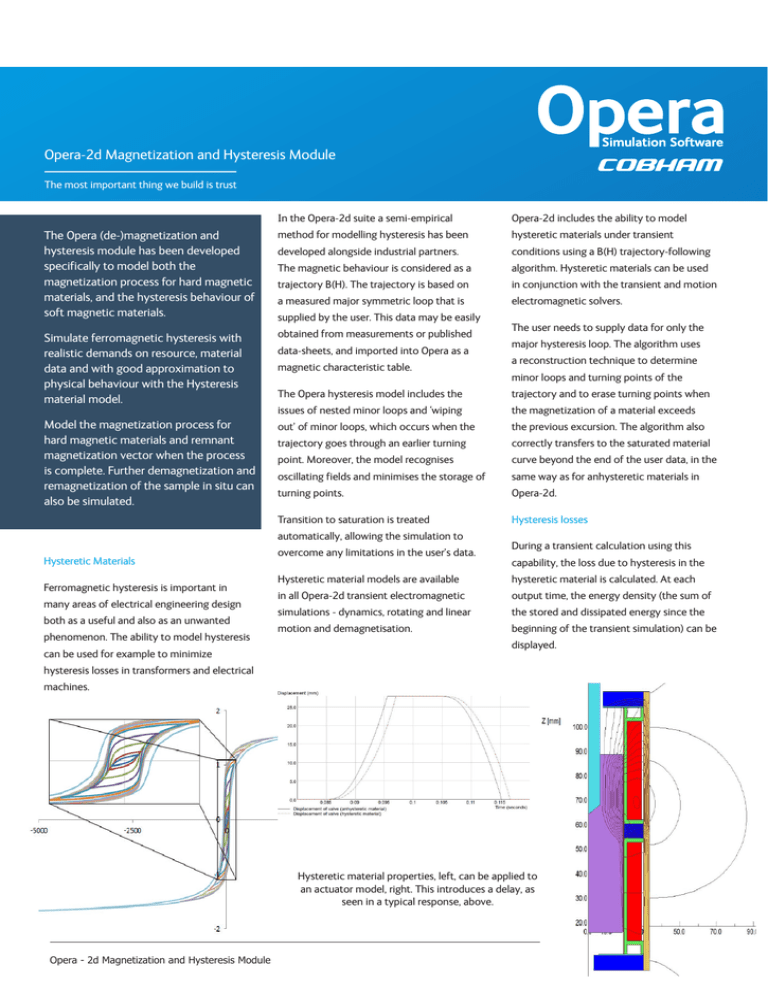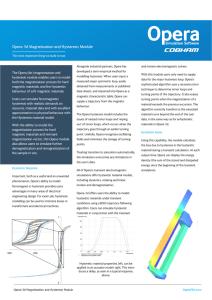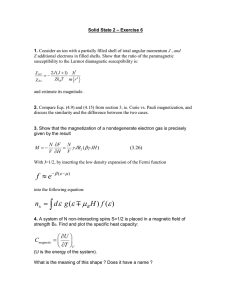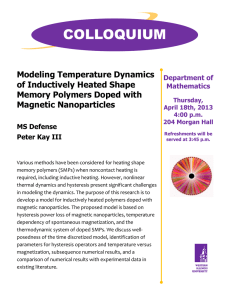Opera-2d Magnetization and Hysteresis Module
advertisement

Opera-2d Magnetization and Hysteresis Module The most important thing we build is trust In the Opera-2d suite a semi-empirical Opera-2d includes the ability to model The Opera (de-)magnetization and hysteresis module has been developed specifically to model both the magnetization process for hard magnetic materials, and the hysteresis behaviour of soft magnetic materials. method for modelling hysteresis has been hysteretic materials under transient developed alongside industrial partners. conditions using a B(H) trajectory-following The magnetic behaviour is considered as a algorithm. Hysteretic materials can be used trajectory B(H). The trajectory is based on in conjunction with the transient and motion a measured major symmetric loop that is electromagnetic solvers. Simulate ferromagnetic hysteresis with realistic demands on resource, material data and with good approximation to physical behaviour with the Hysteresis material model. obtained from measurements or published Model the magnetization process for hard magnetic materials and remnant magnetization vector when the process is complete. Further demagnetization and remagnetization of the sample in situ can also be simulated. supplied by the user. This data may be easily data-sheets, and imported into Opera as a magnetic characteristic table. Ferromagnetic hysteresis is important in many areas of electrical engineering design both as a useful and also as an unwanted phenomenon. The ability to model hysteresis can be used for example to minimize major hysteresis loop. The algorithm uses a reconstruction technique to determine minor loops and turning points of the The Opera hysteresis model includes the trajectory and to erase turning points when issues of nested minor loops and ‘wiping the magnetization of a material exceeds out’ of minor loops, which occurs when the the previous excursion. The algorithm also trajectory goes through an earlier turning correctly transfers to the saturated material point. Moreover, the model recognises curve beyond the end of the user data, in the oscillating fields and minimises the storage of same way as for anhysteretic materials in turning points. Opera-2d. Transition to saturation is treated Hysteresis losses automatically, allowing the simulation to Hysteretic Materials The user needs to supply data for only the overcome any limitations in the user’s data. During a transient calculation using this capability, the loss due to hysteresis in the Hysteretic material models are available hysteretic material is calculated. At each in all Opera-2d transient electromagnetic output time, the energy density (the sum of simulations - dynamics, rotating and linear the stored and dissipated energy since the motion and demagnetisation. beginning of the transient simulation) can be displayed. hysteresis losses in transformers and electrical machines. Hysteretic material properties, left, can be applied to an actuator model, right. This introduces a delay, as seen in a typical response, above. Opera - 2d Magnetization and Hysteresis Module OperaFEA.com Opera-2d Magnetization and Hysteresis Module The most important thing we build is trust a simulation where the applied field from Magnetization and Demagnetization of current sources etc are opposing the magnet’s Permanent Magnets field, the variables will show the operating With hard magnetic materials, the point of the magnet. In a transient simulation, simulation records the progress of the they will show the lowest operating point that material magnetization along the virgin was reached during the transient event. characteristic, until the magnetizing field Remagnetization: starts to reduce. Secondary ‘demagnetization’ If the flux density in element moves into the characteristics are then used to determine the remnant magnetization vector when the irreversible part of the 2nd (or 3rd) quadrant It covers three scenarios: curve, i.e. goes beyond the knee of the the magnetization and demagnetization Magnetization: curve, and the demagnetizing field is then processes, the effect of eddy currents and During the magnetization process, the circuit transients are captured. maximum value of the flux density in each magnetization process is complete. In both element is monitored and stored. The result is a magnetized sample, where the magnetization distribution is correctly subsequently removed, the remagnetization curve is a straight line defined by its slope (the recoil permeability) and the relevant point on the demagnetization curve. Demagnetization in service can be modelled. defined. This can then be used in other The minimum field will be tracked and simulations to model the performance of updated during subsequent simulations, and the magnetized sample in its designated the appropriate demagnetization curve or application (eg. an electrical machine). recoil permeability will be used. During the simulation of the application further demagnetization and remagnetization of the sample in the application device due to the presence of current sources can also be modelled. Demagnetization: During demagnetization, the values of The Opera-2d (de-)magnetization analysis the pre-stored values determine which module (DEMAG) can be used to compute demagnetization (second quadrant) curve the magnetization of permanent magnet each element follows and its direction of materials by time varying electromagnetic magnetization. Again the flux density in fields in three dimensions including the each element is monitored and the minimum effects of eddy currents. values are stored in variables. The values can then be transferred to the standard Opera transient solvers. In such Cobham Technical Services UK Network House, Langford Locks, Kidlington, Oxfordshire, OX5 1LH T: +44 (0)1865 370151 F: +44 (0)1865 370277 E: vectorfields.info@cobham.com USA 1700 N Farnsworth Ave, Aurora, IL 60505, USA. T: +1 (630) 851 1734 F: +1 (630) 851 2106 E: vectorfieldsinc.info@cobham.com operaFEA.com ©2016 Cobham Technical Services trading as Chelton LTD. Specifications subject to change without notice. Any trade names or marks used are the property of their owners and are recognized, including Simulink (a trademark of MathWorks).




